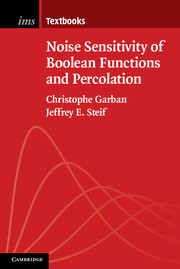Book contents
- Frontmatter
- Dedication
- Contents
- Preface
- Notations
- 1 Boolean functions and key concepts
- 2 Percolation in a nutshell
- 3 Sharp thresholds and the critical point for 2-d percolation
- 4 Fourier analysis of Boolean functions (first facts)
- 5 Hypercontractivity and its applications
- 6 First evidence of noise sensitivity of percolation
- 7 Anomalous fluctuations
- 8 Randomized algorithms and noise sensitivity
- 9 The spectral sample
- 10 Sharp noise sensitivity of percolation
- 11 Applications to dynamical percolation
- 12 For the connoisseur
- 13 Further directions and open problems
- References
- Index
- References
References
Published online by Cambridge University Press: 18 December 2014
- Frontmatter
- Dedication
- Contents
- Preface
- Notations
- 1 Boolean functions and key concepts
- 2 Percolation in a nutshell
- 3 Sharp thresholds and the critical point for 2-d percolation
- 4 Fourier analysis of Boolean functions (first facts)
- 5 Hypercontractivity and its applications
- 6 First evidence of noise sensitivity of percolation
- 7 Anomalous fluctuations
- 8 Randomized algorithms and noise sensitivity
- 9 The spectral sample
- 10 Sharp noise sensitivity of percolation
- 11 Applications to dynamical percolation
- 12 For the connoisseur
- 13 Further directions and open problems
- References
- Index
- References
- Type
- Chapter
- Information
- Noise Sensitivity of Boolean Functions and Percolation , pp. 197 - 202Publisher: Cambridge University PressPrint publication year: 2014

